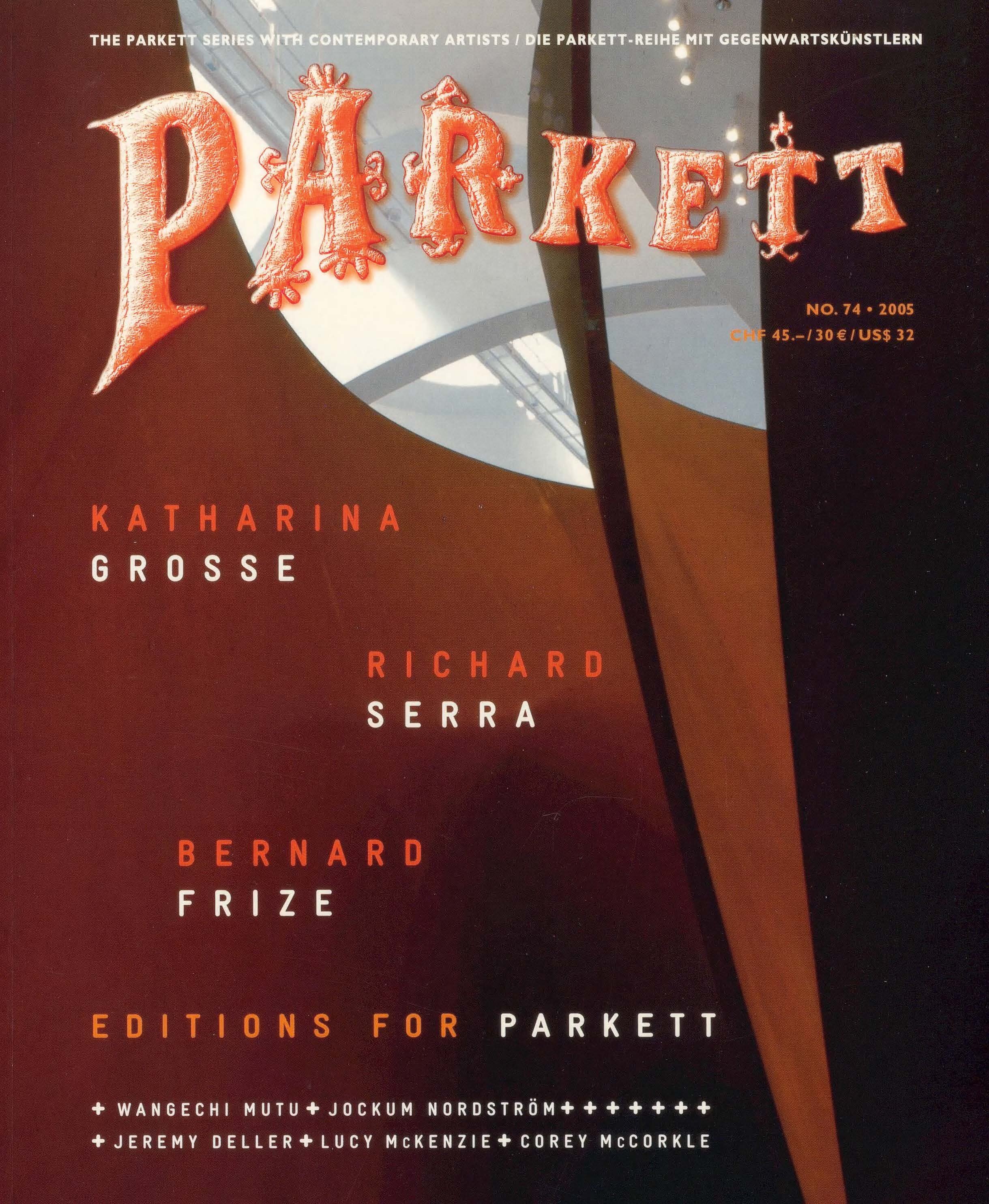 Image 1 of
Image 1 of

Parkett Vol. 74 - 2005
Bernard Frize, Katharina Grosse, Richard Serra
Bernard Frize
Read a selected text (PDF)
View edition
Katharina Grosse
Read a selected text (PDF)
View edition
Richard Serra
Read a selected text (PDF)
View edition
Spine: Carsten Nicolai
Cumulus:
On the Mission School in San Francisco by Lawrence Rinder (PDF)
On the authenticity of artworks by Christy Lange (PDF)
Miscellaneous:
Wangechi Mutu by Isolde Brielmaier (PDF)
U.S. & Canada
Please place your order through our distributor D.A.P. here.
Bernard Frize
Read a selected text (PDF)
View edition
Katharina Grosse
Read a selected text (PDF)
View edition
Richard Serra
Read a selected text (PDF)
View edition
Spine: Carsten Nicolai
Cumulus:
On the Mission School in San Francisco by Lawrence Rinder (PDF)
On the authenticity of artworks by Christy Lange (PDF)
Miscellaneous:
Wangechi Mutu by Isolde Brielmaier (PDF)
U.S. & Canada
Please place your order through our distributor D.A.P. here.
Bernard Frize
Read a selected text (PDF)
View edition
Katharina Grosse
Read a selected text (PDF)
View edition
Richard Serra
Read a selected text (PDF)
View edition
Spine: Carsten Nicolai
Cumulus:
On the Mission School in San Francisco by Lawrence Rinder (PDF)
On the authenticity of artworks by Christy Lange (PDF)
Miscellaneous:
Wangechi Mutu by Isolde Brielmaier (PDF)
U.S. & Canada
Please place your order through our distributor D.A.P. here.
Browse Selected Texts and more on the Collaboration Artists
Editorial
The art in this issue of Parkett is far-reaching. It reaches out physically and mentally; it occupies new territories and makes startlingly self-evident use of materials (Richard Serra); it leaves a traceable trail and takes permanent shape in abstract-concrete pictorial spaces and expanses of color (Bernard Frize); it moves lightly and in torrents, flooding into and over real, furnished rooms (Katharina Grosse). The result is not unexpected: concepts, ideas, and conventions are not only recalibrated, they are at times subjected to radical transformation.
This is art that expands the act of seeing and keeps viewers on the move; it is art that reminds us just how much the entire body participates in seeing. Kate D. Nesin describes that experience in her study of AFANGAR, a work of 1990 that Serra has spread across the landscape of Iceland. Her title: “Walking and Looking”.
In the work of Bernard Frize, the collective is already involved in the act of painting: as in dance, it interprets a score provided by Frize, a “diagram,” with its members mutually agreeing on when to hand over the brush. “Each painting, therefore, is a performance, or a happening” (Patricia Falguières).
The public joins both Bernard Frize and Katharina Grosse only after the fact, when the action is over. Gregory Volk calls the tangible contrast between Grosse’s “intimate” act of painting (executed in a protective suit and mask) and the invasive result of “uninhibited thinking in public space.” The contrast yields a dual focus inasmuch as “the space, as it is, coexists with how it has been outrageously transformed”, an especially apt observation as shown in the reproductions of the artist‘s interventions at Toronto’s International Airport and the Palais de Tokyo in Paris.
As suggestive as the pictures of Richard Serra‘s eight gigantic, enterable steel sculptures at the Guggenheim Museum in Bilbao may be, the key to “seeing” this recent work is undoubtedly the physical experience of walking through the space of the sculptures and specifically sensing time. The group, tellingly titled “A Matter of Time,” is fittingly honored as the sum of Serra’s oeuvre in the discerning analyses of Hal Foster and Kenneth Baker.
As different as these three artists appear on the surface, they all explore fundamental activities, elements, and materials—and they reach out into the social sphere for, instead of inviting contemplation, the works they create call upon viewers to take active part in the mental task of undoing boundaries.
Table of Content
Wangechi Mutu, Re-Imagining the World by Isolde Brielmaier
Orgies of Modernization: Jackum Nordström’s Exemplary World by Lytle Shaw
Richard Serra
Richard Serra in Bilbao by Hal Foster
Walking and Looking on Videy Island by Kate D. Nesin
Richard Serra’s List of Verbs by Theodora Vischer
The Mind’s Mobility by Kenneth Baker
Bernard Frize
Art and Industry by Katy Siegel & Paul Mattick
The Reconstitution of Time Past by Jordan Kantor
The Politics of Colors by Patricia Falguières
Katharina Grosse
Uninhibited Thinking in Public Space by Gregory Volk
Orly, Hans Ulrich Obrist in Conversation with Katharina Grosse
Reflexive by Roman Kurzmeyer
Jeremy Deller: For the Love of the People by Nato Thompson
At Work, Lucy McKenzie by Dominic van den Boogerd
Cosmic Fiction and Function: The Promise of Corey McCorkle’s Work by Christina Végh
Trisha Brown: Esprit de Corps, Les Infos du Paradis by Louise Neri
Learning at the Mission School, Cumulus from America by Lawrence Rinder
A Story I Want to Believe, Cumulus from Anerica by Christy Lange



